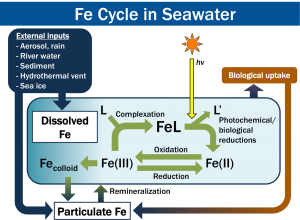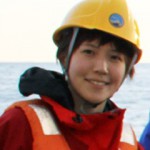Yoshiko Kondo
Role of organic ligands for iron transport in the Oyashio, Kuroshio, and their origin areas
Research summary
Iron (Fe) is well known as a key resource for primary productivity and material cycles in the ocean. Fe distribution and its bioavailability in seawater depend on the sources, sinks, and chemical speciation. The chemical speciation of Fe is controlled by temperature, pH, redox status and complexation with natural organic ligands. In oxygenated seawater, the thermodynamically favored oxidation state of Fe is Fe(III). Fe(III) is strongly hydrolyzed and its removal is mainly constrained by the formation of strong complex with natural organic ligands. Indeed, it has been demonstrated that most dissolved Fe in seawater is complexed with natural organic ligands. Humic substances, siderophores, cell breakdown products of phytoplankton via zooplankton grazing and virus cell lysis and exopolysaccharides are thought to act as natural organic ligands. In seawater, these natural organic ligands are expected to exist as a mixture. Therefore, it is important to clarify the distribution of organic Fe-binding ligands to elucidate Fe cycle in the ocean. In this study, the distribution of organic Fe-binding ligands is going to be investigated in the western North Pacific including the Oyashio, Kuroshio and their origin areas.
Principle investigator:
Yoshiko Kondo
Nagasaki University, Graduate School of Fisheries and Environmental Sciences, Assistant Professor, Chemical Oceanography
Collaborator: Shigenobu Takeda (Nagasaki University ⋅ Graduate School of Fisheries and Environmental Sciences ⋅ Professor ⋅ Biological Oceanography)
Collaborator: Jun Nishioka (Hokkaido University ⋅ Institute of Low Temperature Science ⋅ Associate Professor ⋅ Chemical Oceanography)
Collaborator: Hajime Obata (The University of Tokyo ⋅ Atmosphere and Ocean Research Institute ⋅ Associate Professor ⋅ Marine Geochemistry)



